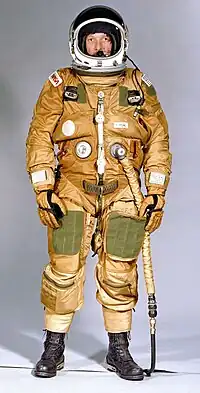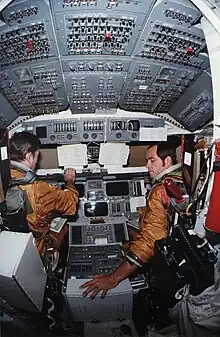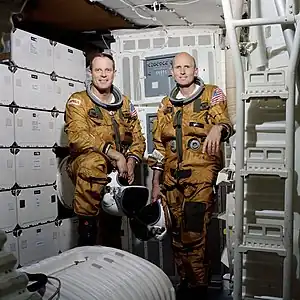
Shuttle Ejection Escape Suit
The Shuttle Ejection Escape Suit was used from STS-1 (1981) to STS-4 (1982) by a two-man crew used in conjunction with Space Shuttle Columbia's ejection seats. It allowed ejections up to Mach 2.7 and 24.4 km (80,000 ft).[1] The suit was manufactured by the David Clark Company of Worcester, Massachusetts. It was derived from the USAF Model S1030 suit, which at the time, was being worn by SR-71 pilots.[1] The Shuttle was certified as operational for STS-5, at which point the escape suits were replaced with light blue coveralls.[1] The seats themselves were deactivated during STS-5 and removed before STS-9, with the intervening flights conducted by Space Shuttle Challenger, which did not have ejection seats.
Specifications
- Name: Shuttle Ejection Escape Suit (S1030A)[2][1]
- Derived from: USAF Model S1030[2][1]
- Manufacturer: David Clark Company[2]
- Missions: STS-1 to STS-4[1]
- Function: Intra-vehicular activity (IVA) and Ejection[2]
- Operating Pressure: 2.7 psi (18.6 kPa)[2]
- Suit Weight: 40 lb (18 kg)[2]
- Primary Life Support: Vehicle Provided[2]
- Backup Life Support: Vehicle Provided[2]
Images
References
Wikimedia Commons has media related to Shuttle Ejection Escape Suit.
- 1 2 3 4 5 6 Daniel M.Barry and John W. Bassick (July 1995). "25th International Conference on Environmental Systems: NASA Space Shuttle Advanced Crew Escape Suit Development". San Diego, California: David Clark Company/SAE International. Retrieved 6 October 2014.
- 1 2 3 4 5 6 7 8 Kenneth S. Thomas & Harold J. McMann (2006). US Spacesuits. Chichester, UK: Praxis Publishing Ltd. p. 374. ISBN 0-387-27919-9.
- Kenneth S. Thomas & Harold J. McMann (2006). US Spacesuits. Chichester, UK: Praxis Publishing Ltd. pp. 38, 368. ISBN 0-387-27919-9.
This article is issued from Wikipedia. The text is licensed under Creative Commons - Attribution - Sharealike. Additional terms may apply for the media files.



